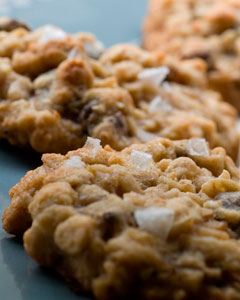The Meadow, a store that offers more than 100 types of gourmet salt, opened in the West Village this past November. At first glance, the timing seems like it couldn’t be worse. Last year, New York City joined the National Salt Reduction Initiative, and Mayor Michael Bloomberg heavily publicized the campaign to lower sodium in foods. The initiative was just the start to a much more nuanced debate, one that was dubbed “the Salt Wars,” by former New York Times columnist James Tierney.
Arguing for the National Salt Reduction Initiative is Dr. Sonia Angell, director of the cardiovascular disease prevention and control program at the city’s Health and Mental Hygiene Department. “Hypertension is one of the leading causes of heart attack and stroke,” she says. “And when we eat salt, when we get too much salt in our diet, our blood pressure goes up. When our blood pressure goes up it increases our risk for heart attack and stroke. So, as a public health issue, this is of great concern.”
On the other hand, Mark Bitterman, who owns The Meadow with his wife Jennifer Turner Bitterman, says some research shows that salt only elevates blood pressure for a short amount of time. Instead, he prefers to cite the research of Dr. David A. McCarron, a nephrologist at U.C. Davis who argues that humans have a naturally determined appetite for salt and are programmed to satisfy that desire. (More about Dr. McCarron’s critics and supporters here.)

In the end, however, both Bitterman and the city’s health department share one thing in common: the willingness to gang up on pre-packaged, processed, high-sodium foods. “The majority of salt that we get every day is not what we put on at the table,” says Dr. Angell. “It’s not what we put in the food when we’re cooking. It’s actually in the packaged food that we buy in supermarkets and bodegas, and it’s in the restaurant foods when we buy them.“
The similarly named, well-known New York Times food writer Mark Bittman also agreed on that point in an op-ed published this week, noting that “the salt shaker is not the culprit.”
Bitterman says that his store often advocates cooking with little to no salt, instead sprinkling salt on at the end. “A huge thing about how we detect the salt flavor is in the shape of the crystal,” he says. “And, of course, that’s one of the things you lose when you cook a lot of salt into food. You just basically have this homogenous saltiness.”
One of the most basic finishing salts Bitterman recommends is fleur de sel, which he describes as delicately crystaled, minerally and moist. "If you sprinkle this lightly moist, granular salt on top of food, it just hangs out there,” he says. “It’s happy. It doesn’t dissolve into it and it doesn’t suck any moisture out of food.”
Bitterman also recommends Maldon, with its parchment-thin crystals, for baking. All Things Considered host Amy Eddings agrees, adding that she garnishes her chocolate chip cookies with Maldon.
Molokai Red Salt is a deep ruby color because of Hawaii’s volcanic alaea clay and works well on top of pork, seafood, or melon. Bitterman says it’s a good salt to have on hand for fancy presentations.
As for the commonly found kosher salt, the self-described “selmelier” won’t even carry it in his store. “Kosher salt gets a wonderful rap because chefs love it,” says Bitterman. “It’s easy to grab. It’s easy to dose with your fingers. So, if you’re working on the line in a fast paced kitchen and you need to build a season by feel, it’s the natural choice to make. However, kosher salt is entirely refined, so it’s a pure sodium chloride chemical, which doesn’t exist in nature. It’s about as close to a natural food as Velveeta is to a natural cheese.” He also adds that being kosher, which is often associated with being wholesome, actually attests to the absence of brine shrimp and that it is safe for passover.
“We’re really all on the same page here: Bloomberg and everybody else,” says Bitterman. “Don’t buy these processed foods that have salt in it. Unsalted butter is far richer and fuller in flavor. Professionals would never buy salted butter.”
Another point on which everyone can agree is a mutually shared love for cookies. Below is Bitterman’s recipe for Bali Rama Oatmeal Chocolate Chip Cookies.
Bali Rama Oatmeal Chocolate Chip Cookies 
Makes 18 medium-sized cookies
- 1 1/2 cups all-purpose flour
- 1 teaspoon baking soda
- 1 two-finger pinch Bali Rama Pyramid salt, coarsely ground with your fingers
- 2 1/2 cups regular or quick oats (not instant)
- 1 cup (2 sticks) unsalted butter, softened
- 1/2 cup granulated sugar
- 1 cup packed brown sugar
- 1 1/2 teaspoons vanilla extract
- 2 eggs
- 2 cups dark chocolate morsels
- 2 three-finger pinches flake salt, such as Bali Rama Pyramid
Preheat the oven to 350° F and line two cookie sheets with foil.
Mix together the flour, baking soda, the two-finger pinch of Bali Rama Pyramid salt, and oats in a bowl; set aside.
Beat the butter, granulated sugar, brown sugar, and vanilla in a large mixing bowl by hand until well combined. Don’t over mix. Add the eggs and beat by hand until well-combined. Stir in the flour mixture and beat well by hand for about a minute. This will develop some gluten in the batter, which will help the cookies hold their shape and stay chewy. Stir in the chocolate morsels.
Scoop rounded tablespoonfuls of batter and place them about 2 inches apart on the prepared cookie sheets. Sprinkle the cookies with the flake salt and bake just until the edges are browned and the centers are still soft, about 8 minutes.
Remove from the oven and let rest for 3 minutes.
Using a small spatula, transfer the cookies to a cooling rack and allow to cool for at least 20 minutes before devouring. These cookies stay fresh for nigh upon a week if stored in a cookie jar shaped like Winnie the Pooh.